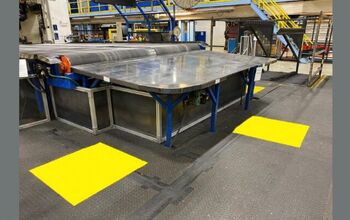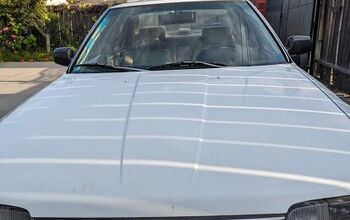Automotive Study Confirms What You Already Know About Buttons VS Touchscreens

If you've ever piloted a modern vehicle, you've likely noticed that touchscreens have started supplanting physical controls. You've also probably found that they're not as easy to interface with as the buttons, switches, and knobs they're replacing. Well, there's another study out that's supporting what drivers have known for years – touchscreens don't make for intuitive vehicle controls and may even make the whole process of getting to your destination a little more treacherous.
While we’ve seen similar studies conducted in the past, Swedish automotive magazine Vi Bilägare conducted a fairly comprehensive test to determine the difference between modern, touchscreen-laden vehicles and their button-reliant predecessors. As you have undoubtedly predicted already, the older setups were the easiest to use.
The outlet seems to have originally set out to compare the touchscreen used in 10 modern vehicles to see who came out on top. But it also threw in a 2005 Volvo V70 to see if an older interface could still hang and it ended up proving itself to be the “easiest car to understand and operate, by a large margin.”
Considering how badly the old Volvo trounced literally every other vehicle tested, that’s an incredibly generous statement. Testers were given time to familiarize themselves with all of the vehicles (10 similarly equipped modern cars and the well-appointed V70) before being issued a series of tasks they would be required to complete as quickly as possible while traveling at 68 mph. This included activating the heated seats; increasing the interior temperature setting by two degrees; switching on the defroster; changing the radio to a specific station; resetting the trip computer; placing the instrumentation lights to their lowest setting; and shutting down the center display.
The 2005 Volvo V70 took just 10 seconds to complete the above tasks, moving just 306 meters within that time frame with the driver barely having to take their eyes off the road. The next fastest vehicles – a modern Volvo C40 and Dacia Sandero – took 13 seconds (almost 14 for the C40) due to the relative simplicity of their touchscreen user interface and retention of physical controls for some frequently used features.
Things were substantially worse on vehicles where more tasks had to be completed via a centrally located screen. The Subaru Outback spent 19.4 seconds running the gauntlet (covering 592 meters), the Tesla Model 3 took 23.5 seconds (717 meters), the Hyundai Ioniq 5 needed 26.7 seconds (815 meters), and the BMW iX required 30.4 seconds (928 meters). While other vehicles were tested – which you’re welcome to peruse here – we’ve only mentioned models that also appear on the North American market.
But you get the gist. More touchscreen time means a larger window for distracted driving. Testers even noted that touchscreens offering a relatively simple interface still required more direct attention than tapping a button – something the outlet suggested could be mitigated by having the screen mounted higher up.
Still, with fatal accidents climbing in recent years, one wonders why more attention wasn’t given to what looks to be an obvious problem. When mobile phones became commonplace, regulators cited them as dangerous distractions and many state legislatures moved to ban their use from behind the wheel. But the automotive industry has worked tirelessly to re-implement them into the dashboard of all modern vehicles, adding new features that encourage drivers to network other devices to their car. It seems like a recipe for disaster. But we know why it was done if we’re willing to be honest with ourselves.
Automakers know that consumers can be dazzled by increasingly large touch screens. In fact, massive screens have become a hallmark of luxury vehicles and obligatory on EVs. They also provide new revenue streams as they open the door to corporate partnerships that can be marketed to drivers and ways of offering new options that can be purchased after taking possession of the car. Manufacturers have also learned it’s often cheaper to install a single touchscreen that controls everything than to design a user-friendly allotment of buttons and switches.
“Inspiration for the screen-heavy interiors in modern cars comes from smartphones and tablets. Designers want a ‘clean’ interior with minimal switchgear, and the financial department wants to lower the cost,” Vi Bilägare wrote. “Instead of developing, manufacturing and keeping physical buttons in stock for years to come, car manufacturers are keen on integrating more functions into a digital screen which can be updated over time.”
[Image: letspicsit/Shutterstock]
Become a TTAC insider. Get the latest news, features, TTAC takes, and everything else that gets to the truth about cars first by subscribing to our newsletter.

A staunch consumer advocate tracking industry trends and regulation. Before joining TTAC, Matt spent a decade working for marketing and research firms based in NYC. Clients included several of the world’s largest automakers, global tire brands, and aftermarket part suppliers. Dissatisfied with the corporate world and resentful of having to wear suits everyday, he pivoted to writing about cars. Since then, that man has become an ardent supporter of the right-to-repair movement, been interviewed on the auto industry by national radio broadcasts, driven more rental cars than anyone ever should, participated in amateur rallying events, and received the requisite minimum training as sanctioned by the SCCA. Handy with a wrench, Matt grew up surrounded by Detroit auto workers and managed to get a pizza delivery job before he was legally eligible. He later found himself driving box trucks through Manhattan, guaranteeing future sympathy for actual truckers. He continues to conduct research pertaining to the automotive sector as an independent contractor and has since moved back to his native Michigan, closer to where the cars are born. A contrarian, Matt claims to prefer understeer — stating that front and all-wheel drive vehicles cater best to his driving style.
More by Matt Posky
Latest Car Reviews
Read moreLatest Product Reviews
Read moreRecent Comments
- CoastieLenn Having formerly worked for Coca Cola (and subsequently having to be part of the union), I'm of the opinion that Unions haven't actually served a viable purpose on the US landscape since about 1971 when OSHA was created. At that point, their main "reason for existence" became threatened so they had to create a new reason to exist- workforce protection. With the passage of the federal Fair Labor Standards Act in 1938 which created the Wage and Hour Commission under the Department of Labor, unions took a huge punch to the guts. Ironically, the FLSA was enacted 3 years after the UAW was formed!Now, all the really serve to do is ensure that ole Bill on that forklift that makes 4x the hourly wage of the younger guys but is 33% as productive can almost never lose his job or seniority based off performance. Bill should have retired 7 years ago, but he's gonna milk the cow for all its worth, and the Union knows it and the company can do nothing about it. /rant
- Sobhuza Trooper No downside to the all-weather tires was mentioned.If they're perfect, then just say so.
- Aja8888 The Tesla service center near me has 12 bays (full all the time) and parking for at least as many cars waiting for service or parts. No oil changes allowed though! Oh, they don't offer a loner vehicle like Lexus does.
- Lorenzo BTW, GM sold 130,342 Malibu's in 2023, up from 115,467 in 2022. They can't make a profit on that volume?
- Jeff There were much worse vehicles to drive at the time than a Cavalier or Sunfire at least they were for the most part reliable and affordable. Its funny that many people complain about there not being enough affordable, reliable, and efficient cars available but complain about them when they are available. At least when you bought a new Cavalier or Sunfire you did not have to mortgage your future and your children's future to buy one like many of today's vehicles. Are most people really better off with a 50k to 100k truck that is more than what most need and is above what many can afford?


































Comments
Join the conversation
It gets a lot of hate, but the turny-button thing in Mazdas is pretty easy to use with clear detents. If you get lost in the system you can hit the home button and try again.
I use the Sync system in mom's Fusion with touch screen and dislike it greatly, but I tend to have a showtime rotisserie attitude about temp controls and set Pandora to shuffle for entertainment.
I have to say the old answer of voice controls in conjunction with the touchscreen as being the answer was always a joke. I tried to get on board, but with strange syntactical requirements it just irked me more than helped. I've had voice recognition in several cars now, and gave up after my first Focus. I just memorized the few menus I needed and moved on.
This driver wants physical knobs and buttons that are easy to use while keeping eyes on the road, and does not want effin screens that require eyeballs to be taken off of roads, mfgs be damned.